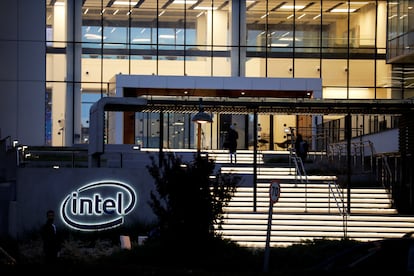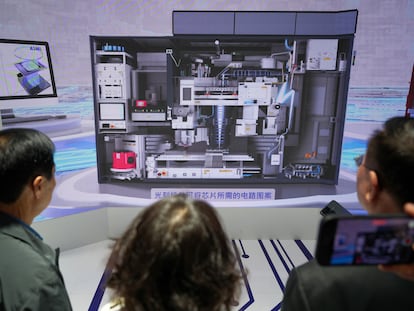Intel, the company that ‘forgot innovation,’ aims to regain lost ground
Once a semiconductor market leader, the company has fallen behind the competition and is now worth 12 times less than Nvidia

While millions of disaffected youths took to the streets of Europe and the United States protesting the Vietnam War and capitalism, another revolution was brewing in Palo Alto. In 1968, Integrated Electronics (later Intel Corporation) was founded by Bob Noyce and Gordon Moore. They foresaw a world needing trillions of tiny transistors for electronic devices and began working on it. In Chip War, Chris Miller’s comprehensive history of the semiconductor industry, the author notes that their dream was not to overthrow the established order, but to reshape it.
The company expanded rapidly while Moore proudly touted Intel’s progress to the news media. “We are the real revolutionaries in today’s world, not those long-haired, bearded rebels from a few years back,” he told a journalist in 1973. By then, Intel had been publicly traded for two years, debuting at share price of $23.50. The company says that’s equivalent to two cents today, due to its 13 stock splits in the 50 years since.
At its peak in 2000, Intel’s share price topped $70, but the turn of the century didn’t bode well. The dot-com bubble burst and the Great Recession dealt another blow, sending shares tumbling below $13 in 2009. Once a leader in personal computers and data centers, technological advances have now left it lagging behind despite significant investments in maintaining its near-monopoly (or duopoly with AMD) from the early 2000s. Dutch company ASML is now the top global maker of lithography machines used in manufacturing cutting-edge microprocessors. Intel competes fiercely with TSMC from Taiwan, Samsung from Korea, and other mobile hardware manufacturers as personal computer sales drop and the mobile market grows. And Nvidia has grabbed a commanding lead in AI chips for the new cloud computing needs.
Investors have propelled chip companies to new heights. ASML holds the second spot in the Eurostoxx 50 index, with a market capitalization of over €350 billion ($376 billion), trailing only behind LVMH, the French luxury goods company. Nvidia has emerged as a major stock market phenomenon this year, leapfrogging Meta and Amazon into third place among the world’s most valuable companies. Its market cap stands at $2.2 trillion, trailing only Microsoft and Apple. “Semiconductors may be to the 21st century what oil was to the 20th,” wrote former Treasury Secretary Lawrence H. Summers. And he may be right.
Amid this boom, Intel has consistently lost ground. With a market cap under $200 billion, it lags behind former rivals like AMD and stands on par with Qualcomm and Texas Instruments. Outside the U.S., Taiwanese manufacturer TSMC, valued at over $700 billion, leads the pack.
Failure to innovate
What happened? One of the chapters of Miller’s book is titled, “How Intel Forgot Innovation.” Miller highlights several missed opportunities, with the most pivotal one revolving around artificial intelligence. This has left Intel vulnerable due to the stagnation in the personal computer market. The AI chips that tech giants like Amazon, Google, Facebook and Microsoft demand are smaller, faster, and more energy-efficient. Nvidia has emerged as the market leader, ending Intel’s decades-long reign in data centers. Intel has also fallen behind TSMC and Samsung in shrinking its chips, vital for staying competitive in an industry focused on nanometer-scale products.
The latest setback for Intel occurred last week when China imposed a ban on government entities using PCs with Intel and AMD processors, as well as the Windows operating system. However, there are reasons for optimism. Intel will benefit from substantial financial aid through U.S. and E.U. government programs to reduce reliance on Asian chips. And Intel revealed plans in March to produce one-nanometer chips by the end of 2027.
Intel’s decline could present a significant opportunity for the company that earned Silicon Valley its nickname. If it can wrest part of the AI chip market from Nvidia, the potential is immense. But there is no guarantee that Intel can make this happen.
Sign up for our weekly newsletter to get more English-language news coverage from EL PAÍS USA Edition
Tu suscripción se está usando en otro dispositivo
¿Quieres añadir otro usuario a tu suscripción?
Si continúas leyendo en este dispositivo, no se podrá leer en el otro.
FlechaTu suscripción se está usando en otro dispositivo y solo puedes acceder a EL PAÍS desde un dispositivo a la vez.
Si quieres compartir tu cuenta, cambia tu suscripción a la modalidad Premium, así podrás añadir otro usuario. Cada uno accederá con su propia cuenta de email, lo que os permitirá personalizar vuestra experiencia en EL PAÍS.
¿Tienes una suscripción de empresa? Accede aquí para contratar más cuentas.
En el caso de no saber quién está usando tu cuenta, te recomendamos cambiar tu contraseña aquí.
Si decides continuar compartiendo tu cuenta, este mensaje se mostrará en tu dispositivo y en el de la otra persona que está usando tu cuenta de forma indefinida, afectando a tu experiencia de lectura. Puedes consultar aquí los términos y condiciones de la suscripción digital.
More information
Archived In
Últimas noticias
The complicated life of Francesca Albanese: A rising figure in Italy but barred from every bank by Trump’s sanctions
How Japan is trying to avert ‘digital defeat’
Half of Scotland is in the hands of 420 property owners
Reinhard Genzel, Nobel laureate in physics: ‘One-minute videos will never give you the truth’
Most viewed
- Pablo Escobar’s hippos: A serious environmental problem, 40 years on
- Why we lost the habit of sleeping in two segments and how that changed our sense of time
- Charles Dubouloz, mountaineering star, retires at 36 with a farewell tour inspired by Walter Bonatti
- Reinhard Genzel, Nobel laureate in physics: ‘One-minute videos will never give you the truth’
- The Florida Keys tourist paradise is besieged by immigration agents: ‘We’ve never seen anything like this’











































